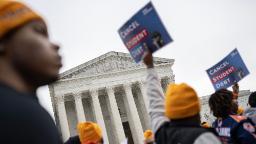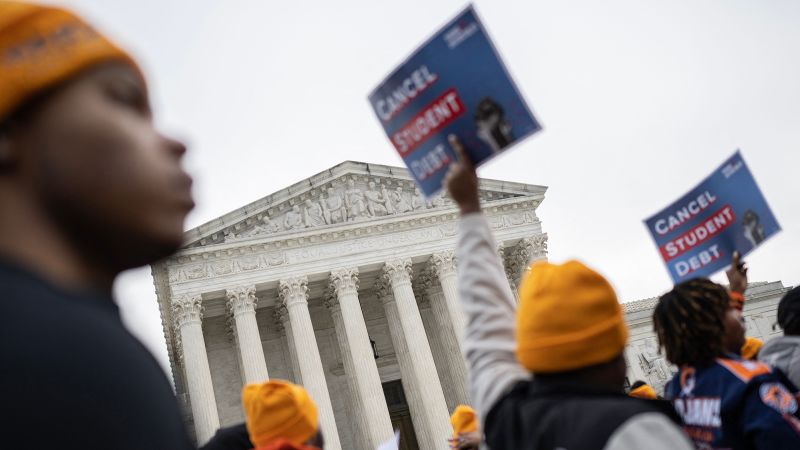
A version of this story appears in CNN’s What Matters newsletter. To get it in your inbox, sign up for free here.
CNN
—
Conservative Supreme Court justices took a predictably dim view Tuesday of President Joe Biden’s controversial plan to forgive up to $20,000 in federal student loans for some borrowers and wipe away nearly half a trillion in debt.
Biden announced the plan last August, just before the midterm election. He had been facing mounting pressure from Democratic lawmakers who called on the president to take executive action as it became clear Congress could not muscle through a more lasting proposal.
Whether the debt forgiveness helped Democrats overperform in that election is up for debate, but the one-sided politics of the plan was a key sticking point for Supreme Court justices who have been skeptical of Biden’s authority to do things without congressional approval.
RELATED: Takeaways from the arguments
One takeaway from Tuesday’s hearing that surprised me: Justice Amy Coney Barrett sounded like a potential swing vote.
The oral arguments were in two cases challenging the program: one brought by a group of Republican-led states and the other brought by two individuals who did not qualify for the full benefits of the forgiveness program. Many of the conservative justices were concerned with fairness, executive overreach and the mechanics of whether states could bring their suit.
Why give borrowers this forgiveness instead of people who worked to pay off their debt early or were unable to take on debt and skipped college?
Those are valid questions, and the idea of debt forgiveness splits the country in half. In national exit polling conducted for the 2022 midterm election, 50% of midterm voters, mostly Democrats, approved of Biden’s debt relief plan, and 47%, mostly Republicans, opposed it.
At arguments Tuesday, Justice Sonia Sotomayor was interested in the millions of people the potential debt forgiveness could affect. Many of them didn’t have the same support lines during the pandemic that others had.
“They don’t have friends or families or others who can help them make these payments,” she said. Those debtors will suffer in ways others won’t because of the pandemic, she said.
The most instructive story I read today on the underlying issue comes from CNN’s Elise Hammond, who digs up data to view the problem of student debt.
More than $1.6 trillion is owed, she writes, a compounding figure that has skyrocketed along with the cost of higher education.
Taking on the debt is an investment, since graduates generally make more money than non-graduates. But debt can hound people for decades. Nearly a quarter of debt is owed by people age 50 and older.
Debt forgiveness is also an avenue to address racial inequality since Black graduates, in particular, tend to graduate with higher debt loads, making it harder for them to capitalize on their degree.
Biden’s proposal would be a big step, but is less complete than a congressionally approved program, and it would only take a bit out of the larger balance sheet and does nothing to address the root problem, which is the cost of college.
Biden authorized up to $10,000 in federal debt forgiveness for most eligible borrowers and up to $20,000 total for borrowers who received a Pell grant while enrolled in college – which means the program is focused on people from lower-income backgrounds trying to break into the middle class.
Interest in the forgiveness has been remarkable:
- More than 40 million borrowers are eligible.
- 26 million have applied so far.
- 16 million have already been approved.
These are people from every part of the country, a point the White House tried to make when it released a list of applicants by congressional district.
Chief Justice John Roberts pointed out during arguments that something that’s going to affect so many people and cost so much money should, to the casual observer, come from Congress.
“And if they haven’t acted on it, then maybe that’s a good lesson to say for the president or the administrative bureaucracy that it’s not something they should undertake on their own,” Roberts said.
The administration points to 9/11-era legislation they say allows the secretary of education to take great power during a national emergency, in this case the pandemic. But justices have recently been skeptical of Covid-related emergency arguments.
No matter what happens at the court, a pandemic-related pause on federal student loan payments that has been in place for nearly three years for all borrowers will be ending at some point. It’s time to start budgeting for the return of those long-deferred loan payments.
The Department of Education has said that regardless of the court’s decision, payments will resume as soon as 60 days after the latest pause ends, on June 30, about the time the Supreme Court is expected to make its decision. That means loan payments could again be required as soon as late August.
CNN’s Aileen Graef talked to people with student debt who gathered outside the court Tuesday and filed this for CNN’s live story on the arguments:
Destiny Perry, a first-generation college student at Morgan State University in Baltimore, lives in a single-parent household of five.
“Right now, I have taken out a lot of loans. … I’m out here trying to just go through college without having to stress about all the payments and everything else,” Perry said.
Perry said she explores scholarship opportunities to offset the debt, but she knows it will not be enough to graduate debt-free.
Glen Lopez, a freshman at Morgan State, described his student debt as a “creeping feeling.” He said that he thinks about the debt “every two to three days.”
Rep. Ayanna Pressley told CNN she knows about student debt from a personal perspective.
“Well, what I was sharing is a story that is certainly no anomaly. This is a systemic crisis – a nearly $2 trillion crisis burning people from every walk of life,” the Massachusetts Democrat said.
“Like those millions of Black borrowers – and I was growing up in single-parent household – and given financial strain, I had no choice but to take out those loans. I ultimately defaulted on those loans and I did pay off those loans, but it took me 20 plus years to do so. And I was gainfully employed and often living check to check and I simply could just not make ends meet. I just could not get ahead,” she said.
In response to opponents’ arguments that people should pay the loans they take out, Pressley said that “hardship is not a character flaw.”
“And despite people’s Herculean efforts working multiple jobs, given rising costs, people are treading water. They’re treading water, and we can do something to alleviate this burden and this hardship,” she said.
There is a separate and extremely important question about whether the six Republican states as well as the two borrowers have “standing” to bring the cases – meaning the legal right to bring the disputes in the first place. In fact, those states’ residents would benefit from the forgiveness.
CNN legal analyst Steve Vladeck, a law professor at the University of Texas at Austin, told CNN’s Kate Bolduan that if the Supreme Court grants standing to the six red states, it has the potential to open up a new era of legal challenges in which states overload the legal system with challenges to any and all presidential actions.
“Does their hostility to this program lead them to really weaken the historical limits on standing?” That’s an issue justices will have to grapple with, according to Vladeck, arguing they could also decide this is a political issue to be decided at the ballot box.

